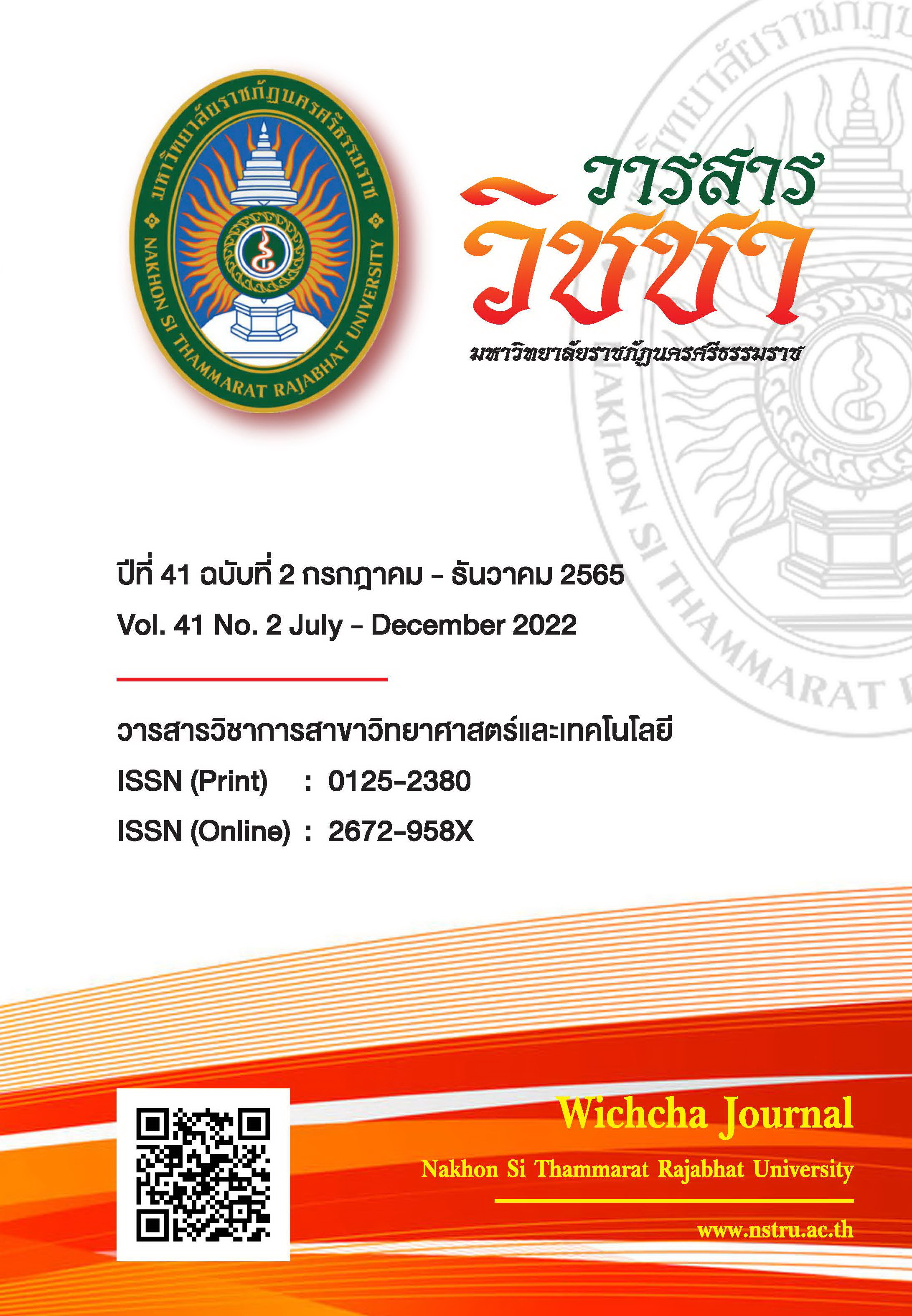Effects of Soil Steaming of Chrysanthemum Stock Cultivating Plots on Soil Microorganisms
Main Article Content
Abstract
Cultivating chrysanthemum on the same land may cause an accumulation of soil-borne pathogens leading to troublesome production and significant loss of the yield. Soil steaming has been reported to be a safe and efficient alternative method for disinfection of the pathogenic fungi. Thus, this study introduced simple method of sheet steaming applied with chrysanthemum fields of a grower in BanMaiPattana, Chaeson, Muangpan, Lampang where cases of soil-borne diseases were found. Sheet steaming started with covering cultivating area (2x12 meter) with plastic sheet, putting a steam inlet hose of the tube steam generator under the field soil which was covered with the sheet. The steaming was done for 90 minutes after heating. After 30 minutes of heating, the soil temperature raised to 57.5-61.8 °C. The steamed soil revealed a decrease of total bacteria number for 2 log cycles. Similarly, total fungi decreased for more than 4 log cycles. The isolation and identification exhibited that there was no Pythium in the soil after steaming, while Fusarium was found in the steamed soil sample that was collected 9-12 meters away from the steam inlet.
Article Details

This work is licensed under a Creative Commons Attribution-NonCommercial-NoDerivatives 4.0 International License.
เนื้อหาและข้อมูลในบทความที่ลงตีพิมพ์ในวารสารวิชชา มหาวิทยาลัยราชภัฏนครศรีธรรมราช ถือเป็นข้อคิดเห็นและความรับผิดชอบของผู้เขียนบทความโดยตรง ซึ่งกองบรรณาธิการวารสารไม่จำเป็นต้องเห็นด้วยหรือร่วมรับผิดชอบใด ๆ
บทความ ข้อมูล เนื้อหา รูปภาพ ฯลฯ ที่ได้รับการตีพิมพ์ในวารสารวิชชา มหาวิทยาลัยราชภัฏนครศรีธรรมราช ถือเป็นลิขสิทธ์ของวารสารวิชชา มหาวิทยาลัยราชภัฏนครศรีธรรมราช หากบุคคลหรือหน่วยงานใดต้องการนำข้อมูลทั้งหมดหรือส่วนหนึ่งส่วนใดไปเผยแพร่ต่อหรือเพื่อการกระทำการใด ๆ จะต้องได้รับอนุญาตเป็นลายลักษณ์อักษรจากวารสารวิชชา มหาวิทยาลัยราชภัฏนครศรีธรรมราชก่อนเท่านั้น
The content and information in the article published in Wichcha journal Nakhon Si Thammarat Rajabhat University, It is the opinion and responsibility of the author of the article. The editorial journals do not need to agree. Or share any responsibility.
References
กิตติมา รามัญวงษ์ วินันท์ดา หิมะมาน จันจิรา อายะวงศ์ และสมโภชน์ มณีรัตน์. (2543). การสำรวจเบื้องต้นเกี่ยวกับราในดินบริเวณเขตรักษาพันธุ์สัตว์ป่าทุ่งใหญ่นเรศวร ด้านตะวันออก. วารสารวิชาการป่าไม้, 2(2), 117-124.
ทิพาพร อยู่วิทยา. (2535). การกำหนดกระบวนการฆ่าเชื้อด้วยความร้อน. อาหาร, 22(4), 39-50.
ธวัชชัย ทีฆชุณหเถียร และศุภณัฏฐ์ กาญจนวัฒนาวงศ์. (ม.ป.ป.). เบญจมาศตัดดอก ที่อำเภอวังน้ำเขียว จังหวัดนครราชสีมา. สืบค้นเมื่อ 20 กรกฎาคม พ.ศ.2565, จาก: http://sutir.sut.ac.th:8080/sutir/bitstream/123456789/2083/1/BIB1284_F.pdf.
เลขา มาโนช. (2555). ราดินและราจากเศษซากพืช. ใน อรอุมา เพียซ้าย. บัญชีรายการทรัพย์สินชีวภาพรา, หน้า 33-50. กรุงเทพฯ: สำนักงานพัฒนาเศรษฐกิจจากฐานชีวภาพ (องค์การมหาชน).
วัชรี เสาร์เทพ อรอุมา เพียซ้าย และพัชรวิภา ใจจักรคำ. (2560). การจำแนกชนิดของเชื้อรา Aspergillus spp. และ Penicillium spp. ที่ปนเปื้อนในอาหารผลิตผลทางการเกษตร และดินเพาะปลูก และการสร้างสารพิษอะฟลาท็อกซิน บี1. วารสารวิทยาศาสตร์เกษตร, 48(1), 127-138.
American Society for Testing and Materials Interntional. (2009). Standard test methods for laboratory compaction characteristics of soil using standard effort (12,400 ft-lbf/ft3 (600 kN-m/m3)). Retrieved 23 July 2022, from: https://www.resolutionmineeis.us/sites/default/files/references/astm-D698.pdf.
Huh, D.A., Chae, W.R., Lim, H.R., Kim, J.H., Kim, Y.S., Kim, Y.W. and Moon, K.W. (2020). Optimizing operating parameters of high-temperature steam for disinfecting total nematodes and bacteria in soil: Application of the box-behnken design. International Journal of Environmental Research and Public Health, 17(14), 5029-5044, doi: https://doi.org/10.3390/ijerph17145029.
Inga, M. (2020). Fusarium wilt problematic on Chrysanthemum in 2020. Retrieved 15 July 2022, from: https://plantpathology.ces.ncsu.edu/2020/09/fusarium-wilt-problematic-on-chrysanthemum-in-2020/.
Luvisi, A., Materazzi, A. and Triolo, E. (2008). Control of soil-borne diseases in tomato by use of steam and an exothermic reaction. Advances in Horticultural Science, 22(3), 174-181.
Roux-Michollet, D., Dudal, Y., Jocteur-Monrozier, L., and Czarnes, S. (2010). Steam treatment of surface soil: How does it affect water-soluble organic matter, C mineralization, and bacterial community composition?. Biology and Fertility of Soils. 46(6), 607-616, doi: https://doi.org/10.1007/s00374-010-0468-6.
Runia, W.T. and Molendijk, L.P.G. (2010). Physical methods for soil disinfection in intensive agriculture: Old methods and new approaches. International Society for Horticultural Science, 883, 249-258, doi: https://doi.org/10.17660/ActaHortic.2010.883.31.
van Loenen, M.C., Turbett, Y., Mullins, C.E., Feilden, N.E., Wilson, M.J., Leifert, C. and Seel, W.E. (2003). Low temperature-short duration steaming of soil kills soil-borne pathogems, nematode pests and weeds. European Journal of Plant Pathology, 109(9), 993-1002, doi: https://doi.org/10.1023/B:EJPP.0000003830.49949.34.


